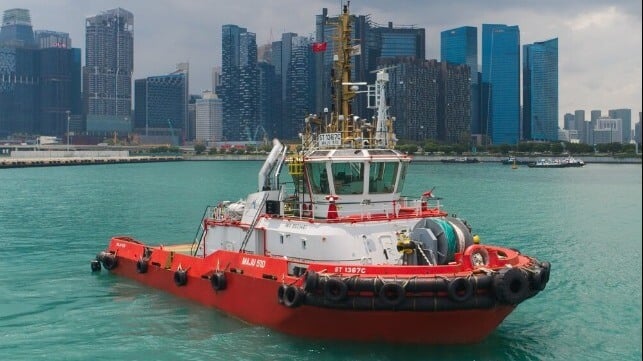Keppel O&M Demonstrates Singapore’s First Autonomous Tug

Keppel Offshore & Marine completed its first autonomous vessel project achieving several industry firsts as the industry continues to advance the development of autonomous vessel technologies. Capable of autonomous vessel navigation as well as collision detection and avoidance, the Maju 510 tug, owned and operated by Keppel Smit Towage, is the first vessel in the world to receive the Autonomous Notation from ABS classification society.
Autonomous vessels and technologies have immense potential to transform the nature of maritime operations,” said Chris Ong, CEO of Keppel O&M. “We are pleased to be setting new records and industry standards at a global scale with the completion of Keppel O&M’s first autonomous tug.”
The tug is the first in South Asia that can be remotely operated by joystick control. It can be controlled from the shore command center with a joystick even for complex maneuvers. Capable of autonomous point navigation, collision detection and avoidance, during the sea trial the tug demonstrated autonomous CDCA capabilities with two dynamic objects with varying speeds and headings.
The remote control feature employs ultra-low latency 4.5G network connectivity to establish standards and data transfer links. The low latency provided reliability for the ship to shore communication and supported mission-critical Internet-of-Things maritime applications.
As the systems integrator for the autonomous solutions, Keppel O&M, through its technology arm, Keppel Marine and Deepwater Technology, set up the shore command center and upgraded the 65-ton bollard pull Maju 510 by retrofitting advanced systems to generate digital situational awareness and high accuracy positioning and maneuvering.
Maju 510 was outfitted with state-of-the-art systems and technologies, such as ABB Ability™ Marine Pilot Vision and Marine Pilot Control, which use artificial intelligence to automate navigational observations, fusion of data from different sources, risk assessment, decision making, and vessel control. The tug was also outfitted with various technologies such as a Digital Twin which simulates vessel behavior in multiple scenarios.
Romi Kaushal, Managing Director of Keppel Smit Towage, said, “Autonomous and remote operations enhance the efficiency and safety of tug operations by adding value with additional traffic and situational operational information. This allows the tug captain and crew to focus on the more crucial tasks of safe tugging operations. We look forward to working with MPA and Keppel O&M to test and deploy more of the tug’s autonomous capabilities.”
The tug became the first vessel in the world to receive the ABS Remote Control Navigation Notation in October 2021. Having now completed the sea trial, it also became the first vessel to receive the Smart (Autonomous) Notation under the Singapore Registry of Ships (SRS) by the Maritime and Port Authority of Singapore. This certifies the tug’s ability to perform autonomous and remote control navigation in a controlled environment with seafarers on board.

that matters most
Get the latest maritime news delivered to your inbox daily.
“The successful trials conducted by Maju 510 Autonomous Tug project signals an important step in the industry’s transformation towards Marine Autonomous Surface Ships,” predicted Professor Chan Eng Soon, CEO of the Technology Centre for Offshore and Marine in Singapore. “The use of a digital twin has helped to establish the behavior and performance of the tug in different operating scenarios. This is an important step to enhance the control and response of the tug, and paves the way to realize safe and efficient autonomous operations in real world conditions.”
Following the completion of the autonomous tug, Keppel O&M and Keppel Smit Towage aim to collaborate with the MPA to test varying degrees of autonomous operations. This will include, interaction and collaborative operations among autonomous vessels, tests in live traffic, remotely supervised autonomous operation with improved port connectivity, and pushing and towing operations.
